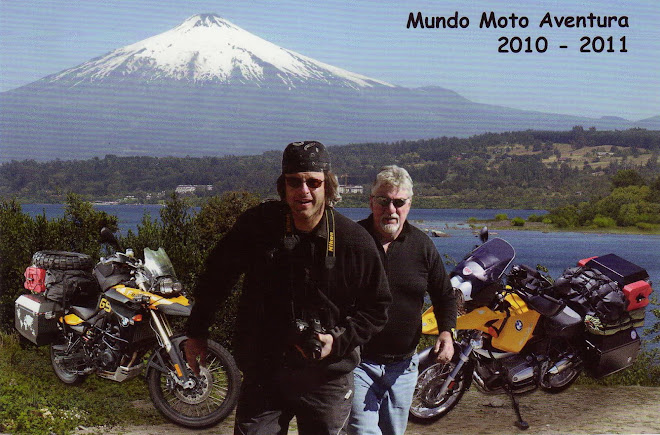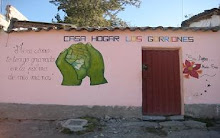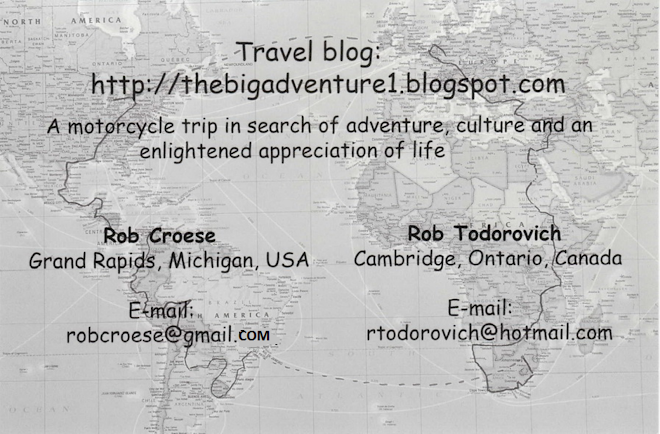RobT: We asked again about road conditions to San Borja (with the idea of going from there to Trinidad, where the pavement starts to Santa Cruz) and again were told the road to Santa Rosa (before getting to San Borja) was packed dirt and in good shape, but if it rains it's a mess, as the trucks and buses create deep ruts, the road gets very slippery and the clay turns to sticky mud. We were already told the route to Trinidad through San Borja was a mess and impassable, so we reverted to "Plan B," from Santa Rosa west to Rurrenabaque. We spoke to a guy this morning who just came from Santa Rosa and he stated we could fly along at 90 kph and get there in about 5 hours, roughly 400 km (325 miles). At that point we had to make a decision whether we had time to get to Rurrenabaque. Before we left Riberalta, we tried fuelling up at one of the petrol stations but there was a long line of motos. We decided to try another. That one was out of fuel. We got lucky at the third one on the way out of town. Since we were looking at 400 plus km without any gas stations, we filled the auxiliary tanks as well. After checking out of town at the police checkpoint, we were on our way.
RobC: The first point of interest south of Riberalta was a visit to the small community of Tumi-Chucua. While working in the 70's and 80's with the Summer Institute of Linguistic in Peru, I knew of a counterpart organization in Bolivia at this community. The SIL work among the indigenous peoples of Bolivia started in 1955 and ended in 1985. The housing at this ex-pat community was very similar to the housing and community structure at Yarinacocha, Peru, where I used to work. We took a number of pictures and spoke with some of the people, who all recalled the foreigners with fondness and they also expressed their sadness that the community had become abandoned and run-down.
Here are a few of the pictures, but if I have time I may also publish a special chapter on Tumi-Chucua with some interviews and more pictures for the people who may be interested in this.
Back on the road to Santa Rosa, traveling at high speed on smooth red clay roads through the jungle, which, like Brazil, was cut down on both sides of the road for cattle raising.
Sheraton five star, jungle style.
RobC cooling off after retrieving water from the well on the left at the "Sheraton." The temperature hit 37 Celcius (100 F), so this was refreshing!!
"Sheraton's" kitchen with pigs and chicken running about.
RobT: The road was an endless ribbon of straight, dusty red dirt surrounded by a huge expanse of green, and when a truck or bus passed coming the opposite direction you couldn’t see a thing for about 5 to 10 seconds until the wind cleared the dust. We stopped midway way at a place called the Sheraton (even denoted itself as a five star restaurant and hotel). You washed your hands and face by dropping a bucket into a well to get your water.
We fuelled up on fried rice with an egg on top and a bottle of Sprite so we were ready for the remaining 220 km of red dust. The jungle crept in on the road in some locations as if trying to reclaim its territory, forcing the road to a single lane. In other spots it was clear-cut back as far as the eye could see. Cattle ranches.
As we neared Santa Rosa, the road became rough, rutted with loose gravel. We entered town for gas as RobC's bike was running on fumes, plus we had used our auxiliary tanks. Santa Rosa looked like it had nothing to offer, a small dusty, run down jungle town, so we hit the road again, heading for Rurrenabaque knowing we`d get there after dark as it was already 5 pm. We heard it was a tourist town with good services and amenities. We were also told that it would take 3 hours to get there and that the road was no problem, with just a few stones. Wrong. The road had ruts, rocks, loose gravel patches, piles of dirt in the middle of the road (used to fill potholes), mud puddles and all of it covered with a thick layer of fine dust. It was like riding through flour, while dodging all the obstacles.
We were already covered in red dust, our eyes hurt, throats dry and we were tired. Once again, we encountered vehicles you could barely see as you approached them due to the dust and since they don’t use their headlights here, you couldn’t tell whether they were coming or going. Passing was almost never done, unless the wind was strong enough to clear the dust and you saw an opening. At one point I managed to pass a bus and RobC was stuck in the blinding dust behind it. I was his eyes up front (communicating by helmet intercom) as he tried to negotiate a way around. Finally, the bus moved to the left side of the road, the wind cleared the dust, so I slowed to interfere with the bus so as to keep it on the left while RobC passed on the right. To add to the problems, the sun started setting and made it even more difficult to see through the haze as it now lingered since the wind had died down.
We were already covered in red dust, our eyes hurt, throats dry and we were tired. Once again, we encountered vehicles you could barely see as you approached them due to the dust and since they don’t use their headlights here, you couldn’t tell whether they were coming or going. Passing was almost never done, unless the wind was strong enough to clear the dust and you saw an opening. At one point I managed to pass a bus and RobC was stuck in the blinding dust behind it. I was his eyes up front (communicating by helmet intercom) as he tried to negotiate a way around. Finally, the bus moved to the left side of the road, the wind cleared the dust, so I slowed to interfere with the bus so as to keep it on the left while RobC passed on the right. To add to the problems, the sun started setting and made it even more difficult to see through the haze as it now lingered since the wind had died down.
Red jungle clay dust
One of the 2 roads that connect the Northern Bolivian jungle to the middle of the country.
This time RobC had the adventure for the day as he found himself in very loose gravel when the bike started swerving from side to side (a near tank slapper), but somehow he managed to keep it upright, followed by a big sigh of relief. As anticipated, we rolled into town after dark, but not before coming across another police checkpoint where they wanted 10 Bolivianos for the use of the road we were on. Huh?! That crappy road had a toll?! Wow.




















The fried rice with an egg on the top sounds very much like the nasi goreng I had for dinner two evenings ago.... [g]
ReplyDeleteDick,
ReplyDeleteHere they call it "huevos a la cubana" and it is a long shot from nasi goreng. Maybe I should have asked for some soy sauce. :-)
Rob